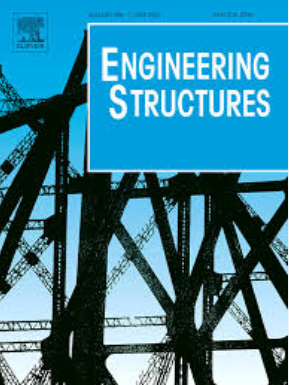A stochastic gradient online learning and prediction method for accelerating structural topology optimization using recurrent neural network
IF 5.6
1区 工程技术
Q1 ENGINEERING, CIVIL
引用次数: 0
Abstract
This study presents a new stochastic gradient online learning and prediction (SGoLap) method for accelerating structural topology optimization. The new method utilizes a one-hidden-layer recurrent neural network (RNN) to learn and predict online derivative information, including the second-order derivative of the objective function, in conjunction with an online learning and prediction strategy, and saves total computational time by selectively skipping FEA and sensitivity analysis steps. In the training module, a stochastic sampling scheme is proposed to reduce the size of training datasets and the number of RNN parameters. In addition to using gradient information, the SGoLap is applied to an approximated and vectorized Hessian matrix to account for contribution of second-order derivative in design variable update and to further reduce computational time. The present numerical results of solving 2D and 3D topology optimization problems demonstrate that the implementation of SGoLap can save up to 99.3 % and 90.9 % of the total computational time respectively.
基于递归神经网络加速结构拓扑优化的随机梯度在线学习与预测方法
提出了一种新的加速结构拓扑优化的随机梯度在线学习与预测(SGoLap)方法。该方法利用单隐层递归神经网络(RNN)在线学习和预测包括目标函数二阶导数在内的导数信息,并结合在线学习和预测策略,选择性地跳过有限元分析和灵敏度分析步骤,节省了总计算时间。在训练模块中,提出了一种随机抽样方案,以减少训练数据集的大小和RNN参数的数量。除了利用梯度信息外,还将SGoLap应用于一个近似和矢量化的Hessian矩阵,以考虑二阶导数对设计变量更新的贡献,进一步减少计算时间。目前求解二维和三维拓扑优化问题的数值结果表明,实现SGoLap可分别节省99.3% %和90.9% %的总计算时间。
本文章由计算机程序翻译,如有差异,请以英文原文为准。
求助全文
约1分钟内获得全文
求助全文
来源期刊

Engineering Structures
工程技术-工程:土木
CiteScore
10.20
自引率
14.50%
发文量
1385
审稿时长
67 days
期刊介绍:
Engineering Structures provides a forum for a broad blend of scientific and technical papers to reflect the evolving needs of the structural engineering and structural mechanics communities. Particularly welcome are contributions dealing with applications of structural engineering and mechanics principles in all areas of technology. The journal aspires to a broad and integrated coverage of the effects of dynamic loadings and of the modelling techniques whereby the structural response to these loadings may be computed.
The scope of Engineering Structures encompasses, but is not restricted to, the following areas: infrastructure engineering; earthquake engineering; structure-fluid-soil interaction; wind engineering; fire engineering; blast engineering; structural reliability/stability; life assessment/integrity; structural health monitoring; multi-hazard engineering; structural dynamics; optimization; expert systems; experimental modelling; performance-based design; multiscale analysis; value engineering.
Topics of interest include: tall buildings; innovative structures; environmentally responsive structures; bridges; stadiums; commercial and public buildings; transmission towers; television and telecommunication masts; foldable structures; cooling towers; plates and shells; suspension structures; protective structures; smart structures; nuclear reactors; dams; pressure vessels; pipelines; tunnels.
Engineering Structures also publishes review articles, short communications and discussions, book reviews, and a diary on international events related to any aspect of structural engineering.
 求助内容:
求助内容: 应助结果提醒方式:
应助结果提醒方式:


